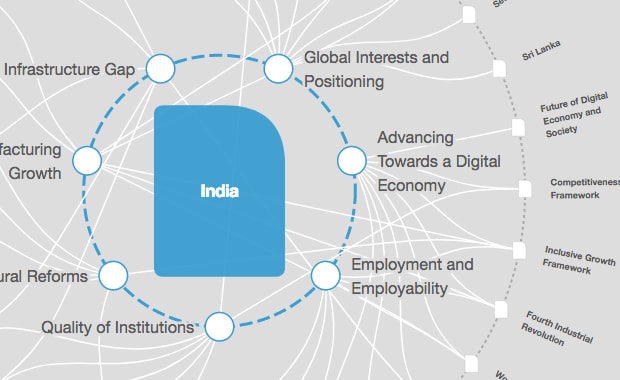Can India drive global growth?


Get involved with our crowdsourced digital platform to deliver impact at scale
Stay up to date:
India
When Prime Minister Narendra Modi was elected with a mandate to revive the Indian economy, he brought upon himself and his colleagues in government a burden of expectation not only to fellow Indians but also to many in the international community.
The world’s most populous democracy, it was thought by many, could be doing more to live up to its enormous economic potential, and was losing out on an historic opportunity to emerge once again as a major global economic power player.
A turnaround in competitiveness
It is too soon, of course, to offer a critical evaluation of Mr Modi’s record in addressing the challenge he has set himself. However, accomplishments in his first year in office suggest a turnaround, at least through the lens of economic competitiveness.
In this year’s World Economic Forum’s Global Competitiveness Report, which sets out every year to assess the long-term economic prospects of over 140 countries, India comprehensively turns around five years of decline. Climbing a total of 16 places in one year to 55th worldwide, India’s performance is one of the strongest seen anywhere in the world.
This ascendance up the ranks arrests a decline that began back in 2008, when the economy was growing at a healthy 8.5% rather than the 5% rate of recent years. The country’s competitiveness, along with its economic growth, had been declining since, with last year representing a nadir as India ranked 71st.
Twelve months ago, the index highlighted infrastructure and the country’s institutions as particularly problematic areas (they ranked 70th and 87th respectively). Yet the past year has witnessed solid signs of progress in both these areas, with its institutions climbing ten places year-on-year to 60th, and infrastructure moving up by six to 81st.
There has also been seen a considerable improvement in the state of the country’s macroeconomic environment over the past twelve months. In the last edition of the index, this fundamental driver of competitiveness was certainly acting as a brake in India, with the Global Competitiveness Report ranking the country 101st and singling out regular government deficits, a narrow tax base and double-digit inflation as particular causes for concern.
This year, we see India climb ten places: this is a solid indicator of progress given the complexity involved in bringing about long-term structural improvements to government finances in any country, let alone one of India’s size.
The secret of India’s resurgence
What has been involved in India’s resurgence in competitiveness? As you may expect with a benchmark that takes into account well over a hundred individual indicators as well as the opinions of the country’s top executives, it is impossible to pinpoint one single act. Rather, and encouragingly, India’s rise can be put down to small yet significant – and hopefully sustainable – reforms across a number of key areas.
These reforms are also beginning to bear fruit: improving infrastructure means removing a key bottleneck to growth and investment and allowing key areas of the economy – farming and manufacturing, for example – to become more productive.
Improved public finances make it easier for the government to invest in areas that will deliver the best returns: education, for instance, where much work still needs to be done, even now that the considerable target of universal education has been reached, or tax incentives for entrepreneurs and wealth creators.
Such reforms also have a tendency of creating a momentum of their own, generating positive sentiment among business and other leaders that in turns lead to investment and job creation.
Perhaps most importantly, however, such momentum will give India’s leaders the encouragement to stay the course and keep to a path of long-term structural reform.
India’s greatest asset
Further improvements can and should be made in steadying the macroeconomic environment, in particular the budget deficit. India is also being helped by low energy prices that contribute to lower inflation and improve the current account budget and national savings.
Investment is critically needed in upgrading the country’s electricity infrastructure, an area in which India has traditionally lagged behind its peers in the emerging world. Education, too, remains a critical area of attention, with the country currently ranking 90th for higher education and training, in order to develop the right talent to ready India’s business for the new technological revolution the global economy is undergoing.
India’s greatest asset by far, its people, have already demonstrated an aptitude for successful global competitiveness by building world-leading companies. With the broad-based fundamental conditions for national competitiveness now falling into place, they could soon be joined by a new generation.
Author: Philipp Rösler is Head of the Centre for Regional Strategies and Member of the Managing Board at the World Economic Forum.
Image: An engineer walks on an iron structure at the construction site of a railway bridge in Kouri in the Reasi district in Jammu and Kashmir state March 4, 2015. REUTERS/Mukesh Gupta
Don't miss any update on this topic
Create a free account and access your personalized content collection with our latest publications and analyses.
License and Republishing
World Economic Forum articles may be republished in accordance with the Creative Commons Attribution-NonCommercial-NoDerivatives 4.0 International Public License, and in accordance with our Terms of Use.
The views expressed in this article are those of the author alone and not the World Economic Forum.
Related topics:
The Agenda Weekly
A weekly update of the most important issues driving the global agenda
You can unsubscribe at any time using the link in our emails. For more details, review our privacy policy.
More on Geographies in DepthSee all
Andrea Willige
April 23, 2024
Libby George
April 19, 2024
Apurv Chhavi
April 18, 2024
Efrem Garlando
April 16, 2024
Babajide Oluwase
April 15, 2024
Rida Tahir
April 9, 2024







